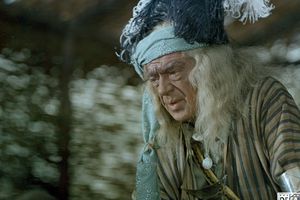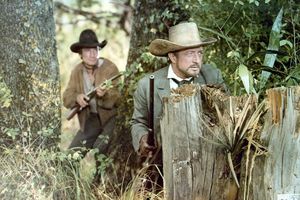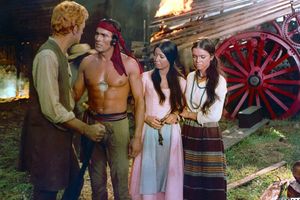Osceola
Director: Konrad Petzold, 108 Min., Color, Feature Film
Deutsche Demokratische Republik (DDR)
DEFA-Studio für Spielfilme, 1971
- Film/Video Format
- 35 mm
- Length in m
- 2976
- English Title
- Osceola
- Premiere Date
- Release Date (for Cinema)
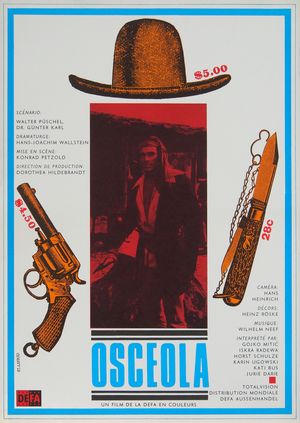
(Dir.: Konrad Petzold, 1971) Graphic Design: El Labbad
Short Summary (English)
The Seminolian Indians are the only tribe to refuse deportation to a reservation. But, devoting themselves to farming and stock breeding in the state of Florida, they are in the way of the white plantation owners.
These Whites not only endeavour to get the Indians' land, but they also refuse to tolerate any longer the situation of ever more black slaves escaping form the plantations to join up with the Seminolians. Thus, the government has decided to resettle them in the state of Oklahoma. Farmer William Raynes, a corrupt slaveholder, demands, however, that all former slaves remain in Florida and be returned to their owners. This standpoint incites public opinion against Moore, a sawmill owner and enlightened Northerner, who not only rejects slavery but also seeks to bring about a peaceful settlement. On their way to Oklahoma, the Seminolians have no idea what the Whites have in store for them: to ambush and kill every single one. Recognizing the impending danger, Chief Osceola warns his people. Only those few who disregard his warning are killed as they attempt to cross the river.
Meanwhile, the government has sent the gunboat "Puma" into the area in order to cut off the Indians' escape route. Osceola manages to blow up the boat.
During the explosion, Moore's sawmill catches fire and is reduced to ashes. These events of I 845 sparked the eight-year Seminolian Indian War.
Source: Progress Film-Verleih
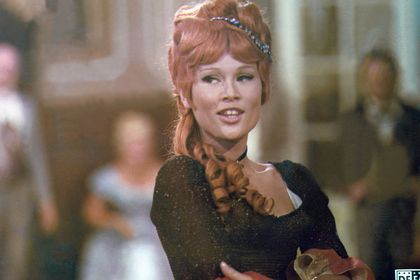
(Dir.: Konrad Petzold, 1971) Photography: Manfred Damm, Detlef Hertelt
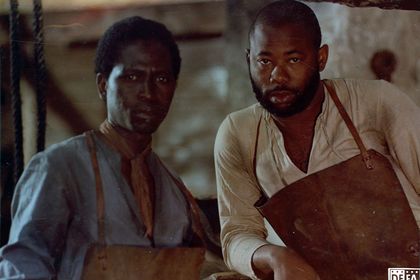
(Dir.: Konrad Petzold, 1971) Photography: Manfred Damm, Detlef Hertelt
Film Crew
- Director
-
- Konrad Petzold
- Script
-
- Günter Karl
- Walter Püschel
- Scenario
-
- Günter Karl
- Walter Püschel
- Camera
-
- Hans Heinrich
- Film Editing
-
- Thea Richter
- Cast
-
- Gojko Mitić (Osceola)
- Horst Schulze (geb. 1921) (Raynes)
- Iurie Darie (Moore)
- Karin Ugowski (Gladis)
- Kati Bus (Zilla)
- Pepa Nikolova (Rhea)
- Iskra Radewa (Che-Cho-Ter)
- Aubrey Pankey (Benjamin)
- William Aniche (Robin)
- Boubacar Touré (Black Panther)
- Josef Quartey (Tom)
- Almany Soumaré (Joshua)
- Gerhard Rachold (Hammer)
- Werner Kanitz (Phipps)
- Gerry Wolff (Gouverneur)
- Wolfgang Greese (Thompson)
- Bruno Carstens (Clinch)
- Kurt Kachlicki (Stock)
- Monika Woytowicz (Peggy Kerry)
- Daniel Michev (Emathla)
- Stefan Peitschev (Mikonopi)
- Ivan Dorin (Arpeika)
- Predrag Milinković (Captain Fletcher)
- Jürgen Frohriep (Leutnant)
- Fritz Mohr (Sergeant)
- Willi Neuenhahn (Maschinist)
- Frank Plange (Heizer)
- Bodo Schmidt (Wirt)
- Diawara Dramané (Arbeiter bei Moore)
- Gerhard Neubauer (Posten (Kellergefängnis))
- Klaus Schwarz (Posten (Kellergefängnis))
- Günter Schubert (Betrunkener Farmer)
- Wilfried Zander (Reiter)
- Victor Keune (Festredner)
- Wilfried Pucher (Munitionsschlepper)
- Heinz Laggies (Munitionsoffizier)
- Günter Ringe (Kanonier)
- Eckhard Bilz (Junger Leutnant)
- Erich Thiede (Bewacher)
- Iskra Apostelova (Indianerin)
- Heinz Fröhlich (Zapfer)
- Werner Schmidt-Winkelmann (Farmer)
- Konrad Petzold (Farmer)
- Hans Feldner (Farmer)
- Otto Schröder (Bewaffneter)
- Günter Herold (Bewaffneter)
- Georg Paplomatas (Posten am Fluss)
- Assistant Director
-
- Thomas Jahn
- Ludmilla Koewa
- Production Design
-
- Heinz Röske
- Script Editing
-
- Hans-Joachim Wallstein
- Music
-
- Wilhelm Neef
- Sound
-
- Peter Dienst
- Georg Gutschmidt
- Musical Performance
-
- Bianca Cavallini (Gesang)
- Etta Cameron (Gesang)
- Costume Design
-
- Günther (auch Günter) Heidemann (geb. Schmidt, auch Schmidt-Heidemann)
- Marianne Schmidt
- Make-Up
-
- Lothar Stäglich
- Christa (auch: Christel) Grewald
- Peter Kuhnert
- Production Management
-
- Dorothea Hildebrandt
- Unit Production Management
-
- Gerrit List
- Ursula Dombrowski
- Design
-
- Gisela Walther (Choreografie)
- Consulting
-
- Lothar Dräger
- Rolf Krusche
- DEFA Photography
-
- Manfred Damm
- Detlef Hertelt
- Dubbing (Dubbing Actor)
-
- Gerhard Paul (Osceola)
- Horst Schön (Moore)
- Evelyn Opoczynski (Zilla)
- Barbara Dittus (Rhea)
- Renate Rennhack (Che-Cho-Ter)
- Lothar Schellhorn (Robin)
- Jürgen Kluckert (Black Panther)
- Hans-Peter Reinecke (Tom)
- Hans Hardt-Hardtloff (Mikonopi)
- Karl Sturm (Apeika)
Short Summary (German)
Die Indianer des Stammes der Seminolen haben sich als Einzige der Deportation in Reservate widersetzt, sich nach Florida zurückgezogen und treiben nun Ackerbau und Viehzucht. Doch sie sind den weißen Pflanzern im Weg. Diese wollen erstens das Land, zweitens sehen sie ihre Existenz dadurch gefährdet, dass immer mehr schwarze Sklaven zu den Seminolen flüchten. Der aus den Nordstaaten stammende Sägewerkbesitzer Moore, mit einer Seminolin verheiratet, ist für friedliche Einigung und gegen die Sklaverei - weil er glaubt, mit freien Lohnarbeitern besseren Profit machen zu können. Plantagenbesitzer Raynes jedoch ist für einen militärischen Vernichtungsschlag. Häuptling Osceola erkennt die Gefahr und versucht, den Provokationen der Weißen auszuweichen. Doch er kann den Ausbruch des Krieges (1835) nicht verhindern.
(Quelle: Das zweite Leben der Filmstadt Babelsberg. DEFA-Spielfilme 1946-1992)
Short Summary (Other Languages)
Dopo essersi opposti al trasferimento in una riserva, gli indiani Seminole si ritirano in Florida coltivando campi e allevando bestiame. Ma la loro presenza disturba gli agricoltori bianchi, che puntano alle loro terre e si sentono minacciati dal fatto che sempre più schiavi di colore fuggano per rifugiarsi nella tribù. Moore, il proprietario di una segheria, sposato con un'indiana Seminole, è a favore di un accordo pacifico e contro la schiavitù, mentre Raynes, proprietario di una piantagione, sarebbe per sterminarli con un intervento militare. Il Capo Osceola, riconoscendo il pericolo, cerca di evitare le provocazioni dei bianchi, senza tuttavia impedire lo scoppio della guerra (1835). (Italienisch)

